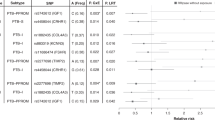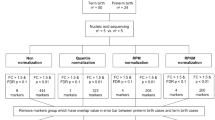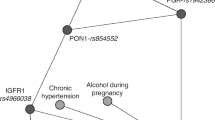Abstract
Background:
Preterm birth (PTB) is a major cause of neonatal mortality and morbidity. There is strong evidence of genetic susceptibility. Objective of this study was to identify genetic variants contributing to PTB.
Methods:
Genotyping was performed for 24 single nucleotide polymorphisms (SNPs) in 4 candidate genes (NR5A2, FSHR, FOXP3, and SERPINH1). Genotyping was completed on 728 maternal triads (mother and maternal grandparents of a preterm infant). Data were analyzed with Family Based Association Test.
Results:
For all maternal triads rs2737667 of NR5A2 showed significant association at P = 0.02. When stratifying by gestational age three SNPs in NR5A2 had P values <0.05 in the <32-wk gestational age group (rs12131233, P = 0.007; rs2737667, P = 0.04; rs2816949, P = 0.02). When preterm premature rupture of membranes cases were excluded rs2737667 of NR5A2 showed the strongest association with a P value <0.0002. This association remained significant after correction for multiple testing.
Conclusion:
This study suggests a potential association between intronic SNPs in the NR5A2 gene and PTB. NR5A2 gene encodes for the liver receptor homolog-1 protein, which plays a critical role in regulation of cholesterol metabolism, steroidogenesis, and progesterone synthesis. These findings suggest that NR5A2 may be important in the pathophysiology of PTB and exploring noncoding regulators of NR5A2 is warranted.
Similar content being viewed by others
Log in or create a free account to read this content
Gain free access to this article, as well as selected content from this journal and more on nature.com
or
References
Beck S, Wojdyla D, Say L, et al. The worldwide incidence of preterm birth: a systematic review of maternal mortality and morbidity. Bull World Health Organ 2010;88:31–8.
Hamilton BE, Martin JA, Osterman MJ, Curtin SC. Births: final data for 2013. Natl Vital Stat Rep. 2015;64:1–65.
Lawn JE, Cousens S, Zupan J ; Lancet Neonatal Survival Steering Team. 4 million neonatal deaths: when? where? why? Lancet 2005;365:891–900.
Serenius F, Källén K, Blennow M, et al.; EXPRESS Group. Neurodevelopmental outcome in extremely preterm infants at 2.5 years after active perinatal care in Sweden. JAMA 2013;309:1810–20.
Moster D, Lie RT, Markestad T. Long-term medical and social consequences of preterm birth. N Engl J Med 2008;359:262–73.
Plunkett J, Muglia LJ. Genetic contributions to preterm birth: implications from epidemiological and genetic association studies. Ann Med 2008;40:167–95.
Muglia LJ, Katz M. The enigma of spontaneous preterm birth. N Engl J Med 2010;362:529–35.
Adams MM, Elam-Evans LD, Wilson HG, Gilbertz DA. Rates of and factors associated with recurrence of preterm delivery. JAMA 2000;283:1591–6.
Winkvist A, Mogren I, Högberg U. Familial patterns in birth characteristics: impact on individual and population risks. Int J Epidemiol 1998;27:248–54.
Porter TF, Fraser AM, Hunter CY, Ward RH, Varner MW. The risk of preterm birth across generations. Obstet Gynecol 1997;90:63–7.
Kistka ZA, Palomar L, Lee KA, et al. Racial disparity in the frequency of recurrence of preterm birth. Am J Obstet Gynecol 2007;196:131.e1–6.
Romero R, Velez Edwards DR, Kusanovic JP, et al. Identification of fetal and maternal single nucleotide polymorphisms in candidate genes that predispose to spontaneous preterm labor with intact membranes. Am J Obstet Gynecol 2010;202:431.e1–34.
Myking S, Myhre R, Gjessing HK, et al. Candidate gene analysis of spontaneous preterm delivery: new insights from re-analysis of a case-control study using case-parent triads and control-mother dyads. BMC Med Genet 2011;12:174.
Haataja R, Karjalainen MK, Luukkonen A, et al. Mapping a new spontaneous preterm birth susceptibility gene, IGF1R, using linkage, haplotype sharing, and association analysis. PLoS Genet 2011;7:e1001293.
Plunkett J, Doniger S, Orabona G, et al. An evolutionary genomic approach to identify genes involved in human birth timing. PLoS Genet 2011;7:e1001365.
Kim J, Stirling KJ, Cooper ME, et al. Sequence variants in oxytocin pathway genes and preterm birth: a candidate gene association study. BMC Med Genet 2013;14:77.
Bream EN, Leppellere CR, Cooper ME, et al. Candidate gene linkage approach to identify DNA variants that predispose to preterm birth. Pediatr Res 2013;73:135–41.
Zhang C, Large MJ, Duggavathi R, et al. Liver receptor homolog-1 is essential for pregnancy. Nat Med 2013;19:1061–6.
Plunkett J, Doniger S, Orabona G, et al. An evolutionary genomic approach to identify genes involved in human birth timing. PLoS Genet 2011;7:e1001365.
Chun S, Plunkett J, Teramo K, Muglia LJ, Fay JC. Fine-mapping an association of FSHR with preterm birth in a Finnish population. PLoS One 2013;8:e78032.
Wang H, Parry S, Macones G, et al. A functional SNP in the promoter of the SERPINH1 gene increases risk of preterm premature rupture of membranes in African Americans. Proc Natl Acad Sci USA 2006;103:13463–7.
Lazarus KA, Wijayakumara D, Chand AL, Simpson ER, Clyne CD. Therapeutic potential of liver receptor homolog-1 modulators. J Steroid Biochem Mol Biol 2012;130:138–46.
Bertolin K, Gossen J, Schoonjans K, Murphy BD. The orphan nuclear receptor Nr5a2 is essential for luteinization in the female mouse ovary. Endocrinology 2014;155:1931–43.
Romero R, Nicolaides K, Conde-Agudelo A, et al. Vaginal progesterone in women with an asymptomatic sonographic short cervix in the midtrimester decreases preterm delivery and neonatal morbidity: a systematic review and metaanalysis of individual patient data. Am J Obstet Gynecol 2012;206:124.e1–19.
Dodd JM, Jones L, Flenady V, Cincotta R, Crowther CA. Prenatal administration of progesterone for preventing preterm birth in women considered to be at risk of preterm birth. Cochrane Database Syst Rev 2013;7:CD004947.
Horvath S, Xu X, Laird NM. The family based association test method: strategies for studying general genotype–phenotype associations. Eur J Hum Genet 2001;9:301–6.
Laird NM, Horvath S, Xu X. Implementing a unified approach to family-based tests of association. Genet Epidemiol 2000;19:Suppl 1:S36–42.
Acknowledgements
We express our sincere thanks to the families that participated in this study. We also thank all the lab members in the Murray, Dagle, and Ryckman laboratories at University of Iowa for their support. This work was supported by March of Dime Foundation (White Plains, NY) #21-FY13-19.
Author information
Authors and Affiliations
Corresponding author
Supplementary information
Supplementary Tables
(DOCX 16 kb)
Rights and permissions
About this article
Cite this article
Kaluarachchi, D., Momany, A., Busch, T. et al. Polymorphisms in NR5A2, gene encoding liver receptor homolog-1 are associated with preterm birth. Pediatr Res 79, 776–780 (2016). https://doi.org/10.1038/pr.2016.7
Received:
Accepted:
Published:
Issue date:
DOI: https://doi.org/10.1038/pr.2016.7
This article is cited by
-
Genetic susceptibility for retinopathy of prematurity and its associated comorbidities
Pediatric Research (2024)
-
Nuclear receptor subfamily 5 group A member 2 (NR5A2): role in health and diseases
Molecular Biology Reports (2021)



